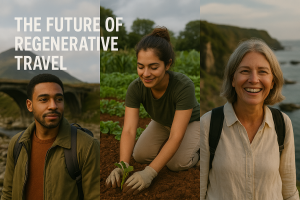
Introduction
As more people travel, they are starting to think about how their trips impact the planet and local communities. Regenerative travel is a new way of traveling that helps improve the places we visit, instead of harming them. This type of travel focuses on protecting nature, supporting local communities, and making the world better for everyone.
In 2025, more people are searching for ways to travel that make a positive difference. Whether it’s by shopping at local stores, joining nature projects, or choosing destinations that care about the environment, regenerative travel allows us to explore the world while creating a positive impact.
In this article, we’ll show you how to plan a trip that benefits both the environment and the local people.
What is Regenerative Travel?

Regenerative travel is all about helping the places you visit become better. It’s not just about avoiding harm, like regular travel. Instead, regenerative travel works to fix and improve the environment, protect local cultures, and make life better for local people. This means leaving a place better than when you found it.
In 2025, regenerative travel is becoming more popular as people look for ways to visit places that are trying to restore nature and help local communities. It’s not just about taking a vacation; it’s about making a difference.
The Benefits of Regenerative Travel
There are many benefits to choosing a regenerative trip. For one, it allows you to actively contribute to the well-being of the places you visit. Instead of just minimizing your environmental impact, regenerative travel goes a step further by focusing on improving the local environment, culture, and economy. Whether it’s through reforestation projects, supporting local artisans, or participating in wildlife conservation efforts, these trips offer travelers a meaningful way to give back. Regenerative travel can also create stronger connections with local communities, fostering a deeper appreciation for their cultures and traditions. By engaging in these experiences, travelers not only learn more about the world but also play an active role in making it a better place.
The Role of Regenerative Travel in Sustainable Tourism

Regenerative travel is an important part of the sustainable tourism movement, which aims to create a better balance in how we travel. While traditional tourism tries to reduce harm to the environment and local communities, revitalising travel goes a step further by helping to restore and improve these areas. It encourages travelers to leave a place better than they found it, whether by planting trees or supporting local businesses that focus on sustainability. Regenerative travel also helps promote fairness, ensuring that the benefits of tourism are shared fairly with the local people. By choosing regenerative travel, tourists can help both the environment and the communities they visit.
Key Parts of Planning a Regenerative Trip

1. Choose Places That Focus on Regeneration
The first step is picking places that are focused on healing the environment. Look for destinations that are working to protect nature, restore land, and support local communities. Some places focus on replanting trees, saving animals, and protecting the oceans. When you visit these areas, your travel money helps fund these efforts and keeps the places beautiful for the future.
Tip: Find destinations like Costa Rica, Iceland, or parts of New Zealand that are known for eco-friendly travel.
2. Support Local Businesses
A big part of revitalising travel is helping local people. Instead of staying in big hotels or eating at fast-food chains, try staying at small, local hotels, eating at family-run restaurants, and shopping at markets where local people sell handmade goods or fresh food.
This helps local businesses grow, creates jobs, and keeps the money you spend in the community.
Tip: Stay at eco-friendly places and look for businesses that care about sustainability.
3. Join in Conservation and Volunteer Programs
A great way to help during your trip is by getting involved in projects that help nature. Many places offer programs where you can volunteer to plant trees, clean up beaches, or help animals. These activities allow you to do something good while connecting more with the place you’re visiting.
For example, you can help restore forests for endangered animals or help save coral reefs. These activities are fun and make a difference.
Tip: Look for eco-tourism tours that offer volunteer activities, where you can help and travel at the same time.
4. Pick Eco-Friendly Places to Stay and Travel
When planning your trip, it’s important to choose eco-friendly places to stay and ways to travel. Stay in hotels or lodges that use clean energy, save water, and reduce waste. Many eco-friendly places use solar power, save water, and recycle, which helps the environment.
For transportation, try to use public buses or bikes, or rent electric cars. It’s best to avoid flying, but if you can’t, try to take a train or bus instead.
Tip: Use websites like EcoHotels.com to find places that care about the environment.
5. Be Responsible with Wildlife Tourism
If you visit places with animals, it’s important to choose tours that respect wildlife. Look for wildlife tours that treat animals kindly and don’t hurt them for fun. Stay away from places that let you ride elephants or hold wild animals for pictures.
Regenerative travel wants to protect animals and their homes, so tourists can watch animals in the wild without disturbing them.
Tip: Choose tours that focus on animal education and conservation, which helps protect animals and their habitats.
The Long-Term Impact of Regenerative Travel

When you plan a revitalising trip, you’re not just having fun you’re also making the world a better place. The good effects of revitalising travel go beyond your trip, as it helps build a better future for everyone by supporting sustainable travel and making the world a safer place.
As more people travel with these principles in mind, they help protect nature, celebrate local cultures, and support community growth. This ensures that future generations can enjoy the same beautiful places and experiences.
The Challenges of Planning a Regenerative Trip
While the idea of regenerative travel is appealing, there are some challenges to making it a reality. One of the main difficulties is finding destinations or organizations that genuinely offer regenerative travel experiences. Some companies may claim to be regenerative without fully following through on their promises, a practice known as “greenwashing.” Additionally, planning a regenerative trip often requires more research and effort than a typical vacation. It may involve looking for eco-conscious accommodations, identifying local projects that need support, and choosing destinations that are truly committed to environmental and social responsibility. Another challenge is the cost; regenerative travel can sometimes be more expensive than traditional tourism due to the focus on sustainability and community support. However, the benefits often outweigh the costs, as these trips provide more meaningful and rewarding experiences.
The Future of Regenerative Travel

Looking ahead, regenerative travel will likely keep growing. As more people become aware of how their travel affects the world, they will choose travel options that do good. We may see even more places offering regenerative travel options, like nature programs and community-based tourism. More governments and travel groups will also support these efforts, making regenerative travel a bigger part of the future.
Comparative Table: Easy Steps to Plan a Regenerative Trip
| Step | Action | Benefits |
|---|---|---|
| Choose Places That Help Nature | Visit eco-friendly destinations | Helps protect nature and supports local communities |
| Support Local Businesses | Stay at small, local hotels and eat at family-run restaurants | Supports local people and creates jobs |
| Join Conservation Projects | Volunteer to help with nature or animals | Makes nature healthier and helps animals |
| Stay at Eco-Friendly Places | Choose hotels that save energy and water | Helps the environment by using less energy |
| Be Kind to Animals | Pick tours that treat animals with respect | Protects animals and their homes |
Conclusion
Regenerative travel is a great way to see the world while making it a better place. By picking destinations that care about nature, supporting local businesses, joining conservation projects, and choosing ethical tours, you can make a positive change wherever you go.
In 2025, regenerative travel is becoming more important as more people look for travel that gives back. Plan your next trip to help the planet and local people, and enjoy the experience of making a difference.
Call to Action
Ready to plan a regenerative trip that helps nature and local communities? Start your journey today and visit our website for tips on eco-friendly travel and sustainable tourism options.










